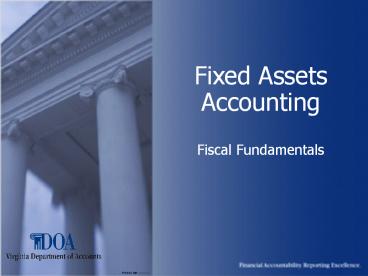Commonwealth of Virginia Fiscal Fundamentals - Fixed Assets - PowerPoint PPT Presentation
1 / 20
Title:
Commonwealth of Virginia Fiscal Fundamentals - Fixed Assets
Description:
Fixed Assets Accounting Fiscal Fundamentals Why Fixed Assets Accounting? The Department of Accounts prepares the Comprehensive Annual Financial Report (CAFR) of the ... – PowerPoint PPT presentation
Number of Views:439
Avg rating:3.0/5.0
Title: Commonwealth of Virginia Fiscal Fundamentals - Fixed Assets
1
Fixed AssetsAccountingFiscal Fundamentals
2
Why Fixed Assets Accounting?
- The Department of Accounts prepares the
Comprehensive Annual Financial Report (CAFR) of
the Commonwealth annually. GASB 34 increased the
importance of fixed asset information in the
CAFR. - The Auditor of Public Accounts audits the CAFR.
- FAACS (Fixed Asset Accounting and Control System)
information is also used for agency financial
statements
3
Purpose of FAACS
- FAACS is the Commonwealths Fixed Asset
- Accounting and Control System. It is a web-
- enabled system with two purposes
- Accounting
- Control
4
Accounting
- It is important to enter accurate information
into FAACS data fields. - As the old saying goes, Garbage in, garbage
out. - FAACS can be very useful if it has correct,
complete, and current data.
5
Accounting
- Virginias CAFR must report historical asset
costs, accumulated depreciation, and depreciation
expense in accordance with generally accepted
accounting principles. - For the CAFR to present fairly Virginias
financial position and results of operations,
accurate data must appear in FAACS accounting,
financial, and other data fields.
6
Accounting Data Elements
- 87 data elements are available in FAACS for each
asset. About 19 are required. Some are - Funding amount (historical cost)
- Acquisition date
- Salvage value (zero is a valid value)
- Useful life (designated by a nomenclature code)
7
Accounting Data Elements
- Generally Accepted Accounting Principles (GAAP)
require that assets be valued at historical cost. - Usually, this is what you paid to buy the asset
plus any related costs required to install the
asset and have it in place and functioning
properly.
8
Accounting Data Elements
- Acquisition date, useful life, and salvage value
must be accurate for the system to properly
calculate depreciation. - There are numerous nomenclature codes. These
11-digit codes are required for all assets in
FAACS. - DOA can add new nomenclature codes if necessary.
9
Accounting Data Elements
- In the past, salvage value was an optional data
element. Now, it is required. - Zero is an allowable salvage value.
- Agencies usually dispose of some types of assets
(such as motor vehicles) by auction. Assets of
these types should have reasonable salvage values.
10
Accounting Documentation
- Accounting information should be based on source
documents. - The voucher that represents payment for the asset
is the primary source document. - This confirms how much was paid for the asset
(historical cost). - Keep copies of vouchers and other related
documents to provide an audit trail.
11
Accounting Reports
- Reports for accounting and financial reporting
come from the Financial Reporting File. - These include the FAC 730, 736, 751 and 767
reports.
12
Accounting - Reconciliations
- Reconciliations should be done to ensure that
accurate data was entered. - Agencies must certify reconciliation of FAACS to
source documents and to CARS on the monthly
confirmation that is submitted to General
Accounting.
13
Accounting Analysis
- A fluctuation analysis is a useful tool for
finding errors in FAACS data. - Compare fixed asset general ledger balances,
acquisitions, and disposals for a period, such as
a fiscal year. - Material changes should be explained.
14
Internal Control (IC)
- Internal Control relates to asset stewardship and
management. Responsibilities include - Tagging
- Recording
- Assigning responsibility
- Performing physical inventory counts
- Reconciling records to FAACS
15
IC Managing Assets
- Important data elements
- Location include FIPS and Building ID
- Responsible person
- Organization Code
- Description
16
IC Managing Assets
Think about the importance of accurate location
and descriptive information for taking a physical
inventory. For a large agency, accurate
classification by organization code would be
helpful. Directly assigned responsibility for
missing items is important.
17
IC Reports
- Reports for control purposes come from the master
file which contains a detailed record for each
asset. - Useful reports include the Master File Snapshot
and the Summarized Master File Presentation.
18
FAACS Master File Downloads
- Agencies can download the FAACS master file into
Excel or Access. - Agencies can then sort, filter, and otherwise
manipulate master file data to produce any report
format desired.
19
References
- CAPP Manual Topics
- 30105, Introduction to Fixed Asset Accounting
- DOA Directives
- 2008 Financial Statement Directive
20
Contacts
- finrept_at_doa.virginia.gov
- 804-225-2257 voice
- 804-225-2430 facsimile
- U. S. Mail
- Virginia Department of Accounts
- Attention Fixed Assets/Leases
- P. O. Box 1971
- Richmond, VA 23218-1971































